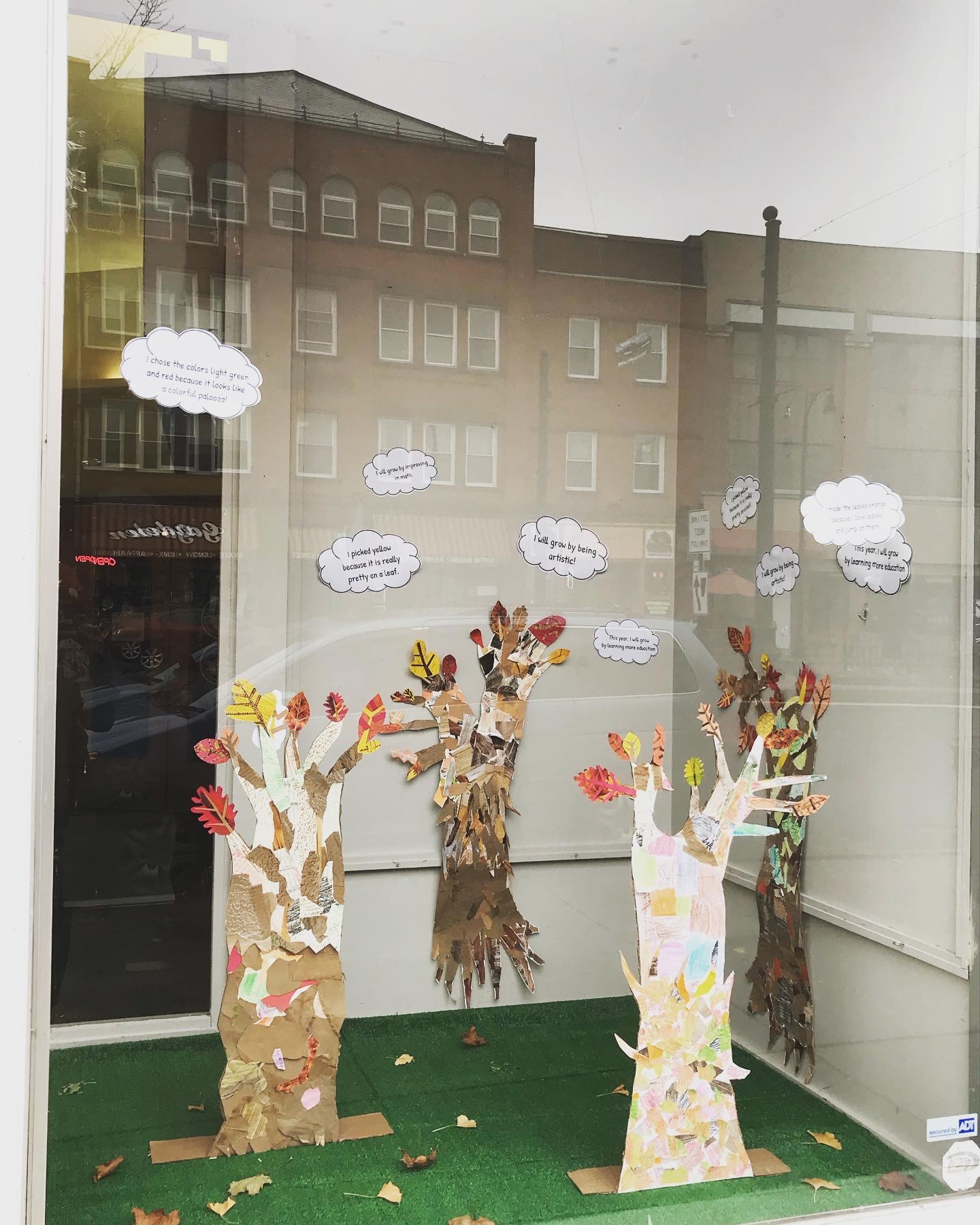BRAINworks mentorships march on, despite the challenge of COVID-19
 An art installation project through a mentorship between IS183 Art School of the Berkshires
and an Egremont fifth-grade class. Students learned collage techniques, with resulting
trees displayed during Pittsfield’s November ArtsWalk at IS183’s Brothership Building
Gallery window on North Street.
An art installation project through a mentorship between IS183 Art School of the Berkshires
and an Egremont fifth-grade class. Students learned collage techniques, with resulting
trees displayed during Pittsfield’s November ArtsWalk at IS183’s Brothership Building
Gallery window on North Street.
Even in a pandemic, mentorship projects between teachers and cultural partners in the Berkshires marched on after connecting through the Berkshire Regional Arts Integration Network (BRAINworks).
BRAINworks, a four-year grant-funded partnership co-directed by MCLA and North Adams Public Schools with a mission of creating a regional vision for arts integration and offering free professional development for Berkshire educators, originally had planned several mentorships as part of its third year of programming, but ended up having to adjust this plan due to the COVID-19 pandemic. This past fall, IS183 Art School of the Berkshires collaborated with students in Judy Callahan’s Egremont Elementary School fifth grade class on collage skills, and the Berkshire Museum worked with Heather Thompson’s class at Taconic High School on developing curriculum for a mobile museum on oceanography.
“Each of these was bespoke,” said Leslie Appleget, BRAINworks project coordinator. The BRAINworks team reached out to educators and cultural organizations about their goals, the kind of programming they’d like to develop, and the kinds of relationships they were genuinely interested in. “These mentorships were designed to individual teachers’ needs, grade level, and classroom.”
IS183 Executive Director Lucie Castaldo and Program Director Brielle Rizzotti ’11 worked with the Egremont fifth-graders via Zoom, teaching collage techniques that each built on the previous week’s session, from making crayon rubbings of different textures to creating leaves and tree trunks, with resulting trees displayed during Pittsfield’s November ArtsWalk at IS183’s Brothership Building Gallery window on North Street.
“They were incredible,” Castaldo said of the fifth-graders. “Each student created their own individual tree trunk, then, when they got to us (for the installation), we moved them around and fit them together so that multiple tree trunks ended up making one tree.” Students also created a “community leaf pile” of different shapes and textures for foliage.
An installation artist herself, Castaldo explored with the fifth-graders what constitutes an art installation, images of tree-themed installations, and the different ways to do collage. “A lot of students in the Berkshires are familiar with installation art through field trips to places like MASS MoCA, but most don’t know the word for it,” she said. “This was much like the Sol LeWitt murals, using pieces to create a large, collaborative installation.”
The Berkshire Museum, which had been in the initial stage of a larger project with the Boston Children’s Museum related to object-based learning through mobile museums, partnered with high school students interested in early education on mobile museum curriculum geared toward young students. “We had this work cued up and ready to go, and it naturally kind of fell into this mentorship as an opportunity to garner even more feedback locally, and engage these students in a project that has national implications,” said museum Chief Experience Officer Craig Langlois.
The mobile museums are small, themed collections of objects that pre-pandemic were designed to be placed around Berkshire County in areas where children could see them, such as doctor’s offices and libraries. The museum staff worked with high school students to build the curriculum for an oceanography exhibit, studying the seven zones of learning the state of Massachusetts uses as an educational standard. “You can start to bring in those bigger concepts—like how ocean acidification impacts shell structure—and tell the story through objects that play a role in that bigger story,” Langlois said.
“They were so skilled at making these interdisciplinary connections,” said BRAINworks Content Manager Dana Schildkraut about the students in these classes. “And our cultural partners were so thorough in their research of this project.”
As part of BRAINworks’ own research, these mentorships will help answer questions about reciprocal learning, what teachers need, and how cultural organizations can meet those needs: “What happens when you make this type of intervention? What happens when you implement that type of curriculum in the classroom? What implications does that have for policy, for teaching in general?” Appleget said. “It’s also an opportunity for students to see you don’t have to be an artist to work at a museum. There are lots of different paths to staying in that sector, and to working in the Berkshires.”
